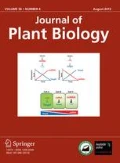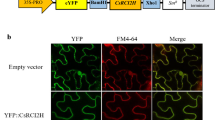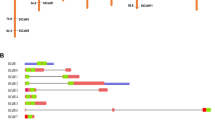Abstract
Rare-cold-inducible 2 (RCI2) genes are involved in plant response to abiotic stresses. In this study, we report the functional role of a Camelina RCI2, CsRCI2D, in plant salt stress response. The localization of CsRCI2D was observed in the plasma membrane and intracellular membranes by confocal analysis in tobacco leaf and western blot analysis in Camelina. The full length CsRCI2D cDNA clone was not able to complement the salt sensitivity of △spmp3 lacking the PMP3 gene. However, a C-terminal tail deleted CsRCI2D cDNA was able to restore the level of salt tolerance to that of WT. CsRCI2D-overexpressing Camelina showed better germination rate and seedling growth. CsRCI2D overexpression decreased Na+ accumulation in both roots and shoots but increased K+ accumulation in the shoots under salt stress. Furthermore, CsRCI2D-overexpressing Camelina displayed lower H2O2 and malondialdehyde (MDA) upon salt stress. Under normal growth condition, CsRCI2D-overexpressing Camelina showed higher transcript levels of all antioxidant genes (CsCuSODs, CsMnSOD1, CsFeSODs, CsCATs, CsAPX1, and CsGR), whereas salt stress significantly induced all antioxidant genes in WT. These results indicate that salt-upregulated CsRCI2D plays a positive role in Camelina seed germination and seedling growth under salt stress by maintenance of ion homeostasis and modulating the expression of antioxidant-related genes.






Similar content being viewed by others
References
Ahmad P, Abdel Latef AA, Hashem A, Abd Allah EF, Gucel S, Tran LS (2016) Nitric oxide mitigates salt stress by regulating levels of osmolytes and antioxidant enzymes in Chickpea. Front Plant Sci 7:868
Ben Romdhane W, Ben-Saad R, Meynard D, Verdeil JL, Azaza J, Zouari N, Fki L, Guiderdoni E, Al-Doss A, Hassairi A (2017) Ectopic expression of Aeluropus littoralis plasma membrane protein gene AlTMP1 confers abiotic stress tolerance in transgenic tobacco by improving water status and cation homeostasis. Int J Mol Sci 18:692
Ben-Romdhane W, Ben-Saad R, Meynard D, Zouari N, Mahjoub A, Fki L, Guiderdoni E, Al-Doss A, Hassairi A (2018) Overexpression of AlTMP2 gene from the halophyte grass Aeluropus littoralis in transgenic tobacco enhances tolerance to different abiotic stresses by improving membrane stability and deregulating some stress-related genes. Protoplasma 255:1161–1177
Chang-Qing Z, Shunsaku N, Shenkui L, Tetsuo T (2008) Characterization of two plasma membrane protein 3 genes (PutPMP3) from the alkali grass, Puccinellia tenuiflora, and functional comparison of the rice homologues, OsLti6a/b from rice. BMB Rep 41:448–454
Duggleby RG, Dennis DT (1973) Pyruvate kinase, a possible regulatory enzyme in higher plants. Plant Physiol 52:312–317
Fu J, Zhang DF, Liu YH, Ying S, Shi YS, Song YC, Li Y, Wang TY (2012) Isolation and characterization of maize PMP3 genes involved in salt stress tolerance. PLoS ONE 7:e31101
Giri B, Kapoor R, Mukerji K (2007) Improved tolerance of Acacia nilotica to salt stress by arbuscular mycorrhiza, Glomus fasciculatum may be partly related to elevated K/Na ratios in root and shoot tissues. Microb Ecol 54:753–760
Heath RL, Packer L (1968) Photoperoxidation in isolated chloroplasts. I. Kinetics and stoichiometry of fatty acid peroxidation. Arch Biochem Biophys 125:189–198
Khurana N, Chauhan H, Khurana P (2015) Characterization of a chloroplast localized wheat membrane protein (TaRCI) and its role in heat, drought and salinity stress tolerance in Arabidopsis thaliana. Plant Gene 4:45–54
Kim HS, Lee JE, Jang HY, Kwak KJ, Ahn SJ (2016) CsRCI2A and CsRCI2E genes show opposite salt sensitivity reaction due to membrane potential control. Acta Physiol Plant 38:1–13
Kim YO, Kang H, Ahn SJ (2019) Overexpression of phytochelatin synthase AtPCS2 enhances salt tolerance in Arabidopsis thaliana. J Plant Physiol 240:153011
Kim YO, Lim HG, Ahn KHS, SJ, (2020) Overexpression of CsRCI2H enhances salt tolerance in Camelina sativa (L.). Plant Biotechnol Rep 14:439–449
Kim HS, Park W, Lee HS, Shin JH, Ahn SJ (2021) Subcellular journey of rare cold inducible 2 protein in plant under stressful condition. Front Plant Sci 11:2201
Liu B, Feng D, Zhang B, Mu P, Zhang Y, He Y, Qi K, Wang J, Wang H (2012) Musa paradisica RCI complements AtRCI and confers Na+ tolerance and K+ sensitivity in Arabidopsis. Plant Sci 184:102–111
Long R, Zhang F, Li Z, Li M, Cong L, Kang J, Zhang T, Zhao Z, Sun Y, Yang Q (2015) Isolation and functional characterization of salt-stress induced RCI2-like genes from Medicago sativa and Medicago truncatula. J Plant Res 128:697–707
Lu C, Kang J (2008) Generation of transgenic plants of a potential oilseed crop Camelina sativa by Agrobacterium-mediated transformation. Plant Cell Rep 27:273–278
Marschner H (1995) Mineral nutrition of higher plants. 2nd ed, Academic Press, New York, NY, USA. Ann Bot 78:527–528
Medina J, Ballesteros ML, Salinas J (2007) Phylogenetic and functional analysis of Arabidopsis RCI2 genes. J Exp Bot 58:4333–4346
Mitsuya S, Taniguchi M, Miyake H, Takabe T (2005) Disruption of RCI2A leads to over-accumulation of Na+ and increased salt sensitivity in Arabidopsis thaliana plants. Planta 222:1001–1009
Mitsuya S, Taniguchi M, Miyake H, Takabe T (2006) Overexpression of RC12A decreases Na+ uptake and mitigates salinity induced damages in Arabidopsis thaliana plants. Physiol Plant 128:95–102
Rocha PS (2016) Plant abiotic stress-related RCI2/PMP3s: multigenes for multiple roles. Planta 243:1–12
Rossatto T, Amaral MN, Benitez LC, Vighi IL, Braga EJB, de Magalhães Júnior AM, Maia MAC, Silvainto L (2017) Gene expression and activity of antioxidant enzymes in rice plants, cv BRS AG, under saline stress. Physiol Mol Biol Plants 23:865–875
Ueda M, Tsutsumi N, Fujimoto M (2016) Salt stress induces internalization of plasma membrane aquaporin into the vacuole in Arabidopsis thaliana. Biochem Biophys Res Commun 474:742–746
Wang W, Vinocur B, Altman A (2003) Plant responses to drought, salinity and extreme temperatures: towards genetic engineering for stress tolerance. Planta 218:1–14
Wu Z, Chen LJ, Long YJ (2009) Analysis of ultrastructure and reactive oxygen species of hyperhydric garlic (Allium sativum L.) shoots. Vitro Cell Dev Biol Plant 45:483–490
You J, Chan Z (2015) ROS Regulation during abiotic stress responses in crop plants. Front Plant Sci 6:1092
Yu Y, Cui YC, Ren C, Rocha PSCF, Peng M, Xu GY, Wang ML, Xia XJ (2016) Transgenic rice expressing a Cassava (Manihot Esculenta Crantz) plasma membrane gene MePMP3-2 exhibits enhanced tolerance to salt and drought sresses. Genet Mol Res 15:1
Acknowledgements
This study was supported by grants from Water Management Research Program Infrastructure and Transport of the Korean Government (18AWMP-B114119-03) and the Basic Science Research Program through the National Research Foundation (NRF) of Korea, funded by the Ministry of Education (NRF-2018R1D1A1B07045677).
Author information
Authors and Affiliations
Contributions
SJA supervised and designed the study. SJA, HGL, YOK, HSK, HYJ, and ESK performed experiment and analyzed data. YOK wrote the manuscript. SJA provided vital advice on the article. All authors read and approved the manuscript.
Corresponding author
Ethics declarations
Conflict of interest
The authors declare no conflict of interests.
Supplementary Information
Below is the link to the electronic supplementary material.
Rights and permissions
About this article
Cite this article
Kim, YO., Kim, HS., Lim, HG. et al. Functional Characterization of Salt‑Stress Induced Rare Cold Inducible Gene from Camelina sativa (CsRCI2D). J. Plant Biol. 65, 279–289 (2022). https://doi.org/10.1007/s12374-021-09313-6
Received:
Revised:
Accepted:
Published:
Issue Date:
DOI: https://doi.org/10.1007/s12374-021-09313-6




